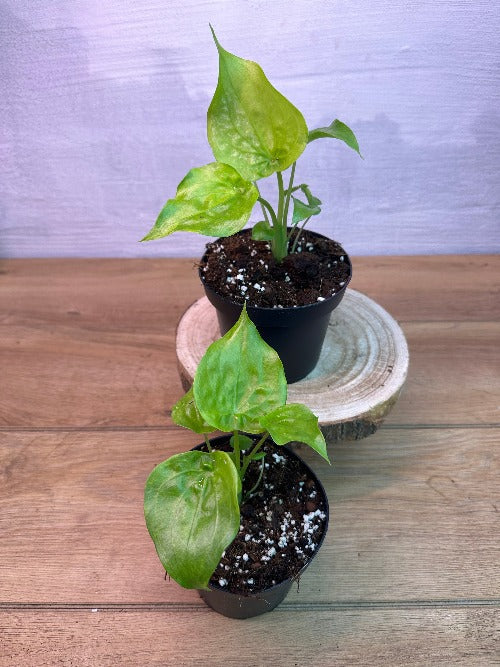42 products
-
Alocasia Watsoniana (Shine Form)
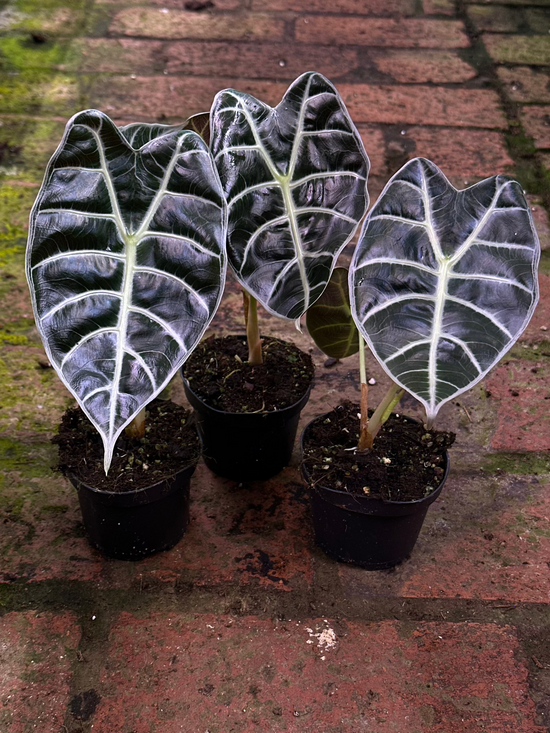 Vendor:Harmony PlantsAlocasia Watsoniana (Shine Form)
Vendor:Harmony PlantsAlocasia Watsoniana (Shine Form)- Regular price
-
€19,00 €45,00 - Regular price
-
- Sale price
-
€19,00 €45,00
-
Alocasia Amazonica Variegata (sectorial) S
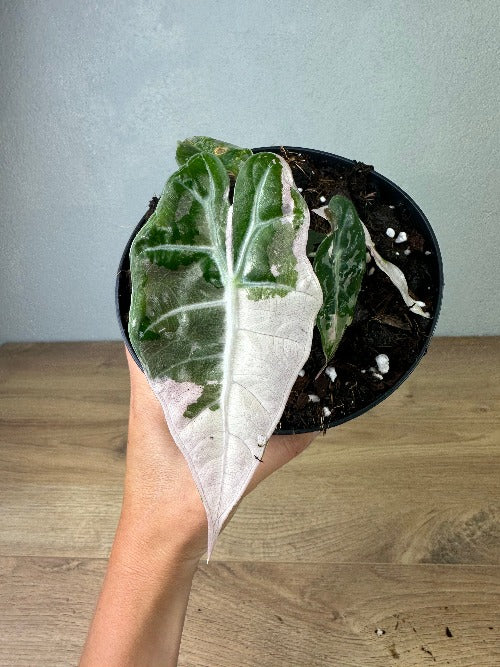 Vendor:Harmony PlantsAlocasia Amazonica Variegata (sectorial) S
Vendor:Harmony PlantsAlocasia Amazonica Variegata (sectorial) S- Regular price
-
€99,00 - Regular price
-
€199,00 - Sale price
-
€99,00
-
Alocasia Macrorrhiza Variegata XXL
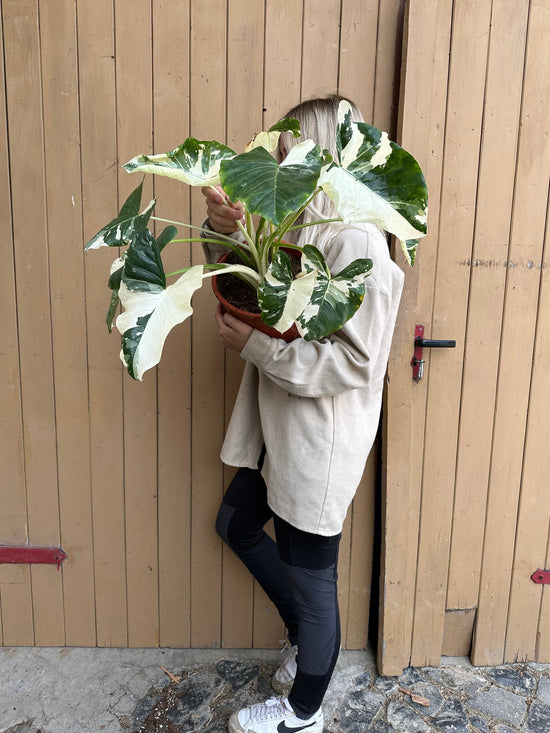 Vendor:Harmony PlantsAlocasia Macrorrhiza Variegata XXL
Vendor:Harmony PlantsAlocasia Macrorrhiza Variegata XXL- Regular price
-
€169,00 - Regular price
-
- Sale price
-
€169,00
-
Alocasia Black Velvet Gold Variegata
 Vendor:Harmony PlantsAlocasia Black Velvet Gold Variegata
Vendor:Harmony PlantsAlocasia Black Velvet Gold Variegata- Regular price
-
€129,00 - Regular price
-
€299,00 - Sale price
-
€129,00
-
Alocasia Pink Dragon Nairobi Nights Variegata
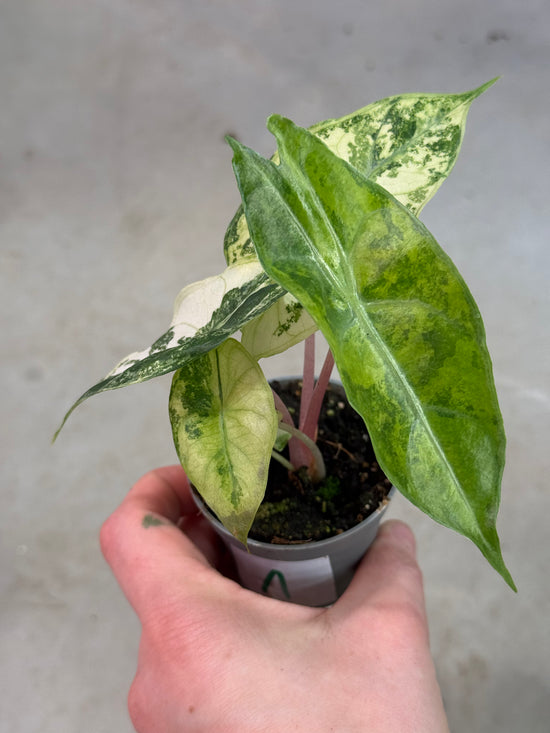 Vendor:Harmony PlantsAlocasia Pink Dragon Nairobi Nights Variegata
Vendor:Harmony PlantsAlocasia Pink Dragon Nairobi Nights Variegata- Regular price
-
€119,00 - Regular price
-
€329,00 - Sale price
-
€119,00
-
Alocasia Wentii Variegata Pink Frekkels
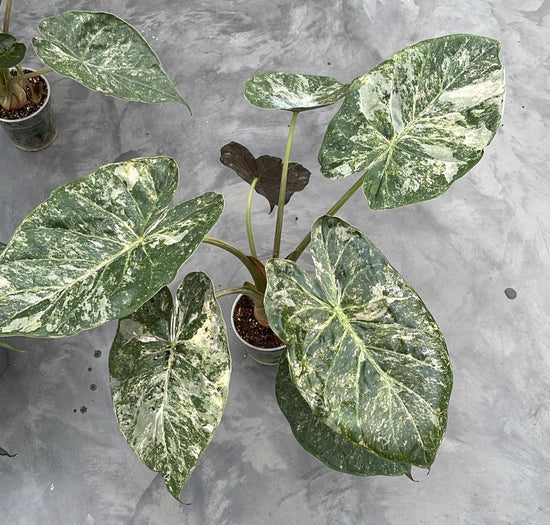 Vendor:Harmony PlantsAlocasia Wentii Variegata Pink Frekkels
Vendor:Harmony PlantsAlocasia Wentii Variegata Pink Frekkels- Regular price
-
€229,00 - Regular price
-
€299,00 - Sale price
-
€229,00
-
Alocasia Zebrina Variegata XXL
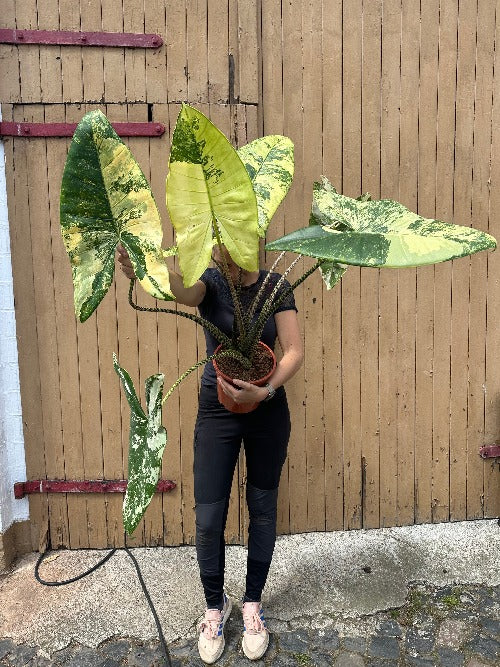 Vendor:Harmony PlantsAlocasia Zebrina Variegata XXL
Vendor:Harmony PlantsAlocasia Zebrina Variegata XXL- Regular price
-
€289,00 €449,00 - Regular price
-
- Sale price
-
€289,00 €449,00
Alocasia: The jewels of the jungle
Dive into our extensive collection of Alocasia plants. With their distinctive leaves and exotic flair, alocasias are an impressive addition to any living space. Browse our range to find the Alocasia that perfectly suits your style and home. Enjoy the variety and choose the ideal Alocasia to bring green accents and tropical elegance into your living spaces. Welcome to the fascinating world of Alocasia plants!
Alocasia, also known as elephant ear plants, is a true treasure among houseplants. Originally native to the humid forests of Southeast Asia, they have found their way into our homes and are enjoying growing popularity. The characteristic feature of Alocasia is undoubtedly its striking leaves. These are large, heart-shaped and often a deep, rich green color that shines in contrast to the surrounding area. But it's not just the shape that impresses - the leaves are often streaked with vibrant patterns in various shades of green. Some varieties even display silver or white markings that resemble works of art.
What makes Alocasias even more remarkable are their bold stems. These can be shiny and sleek or have a deep crimson color that makes for a stunning contrast. Combined with the majestic leaves, the stems give the plant an almost royal elegance. However, alocasias are not only fascinating because of their appearance. They are also comparatively easy to care for and can thrive in a variety of environments. They prefer bright, indirect lighting conditions for optimal growth, but they are also quite adaptable to less bright rooms. Regular watering is crucial, although it is important that the soil does not dry out too much.
As far as humidity is concerned, alocasias like it high. This makes them ideal plants for bathrooms or kitchens where humidity is naturally higher. Alternatively, you can approach them with regular misting or increased humidity through the use of humidifiers or bowls of water. Not only are alocasias breathtakingly beautiful, but they also help purify the air indoors. They filter harmful substances from the air and thus improve indoor air quality. In addition, they give every room a piece of tropical paradise.
Die besonderen Blätter der Alocasia
Das charakteristische Merkmal der Alocasien sind zweifellos ihre auffälligen Blätter. Die herzförmigen, großen Blätter der Alocasia leuchten in sattem Grün und setzen sich eindrucksvoll von ihrer Umgebung ab. Manche Arten erreichen eine Blattlänge von bis zu einem Meter – ein wahrer Blickfang in jedem Raum. Doch nicht nur die Größe ist beeindruckend: Viele Blätter sind von lebendigen Mustern durchzogen, in unterschiedlichsten Grüntönen. Einige Sorten zeigen sogar silberne oder weiße Zeichnungen, die fast schon wie kleine Kunstwerke wirken.
Was die Alocasien noch bemerkenswerter macht, sind ihre gewagten Stiele. Diese können glänzend und schlank sein oder eine tief purpurrote Farbe aufweisen, die für einen atemberaubenden Kontrast sorgt. In Verbindung mit den majestätischen Blättern verleihen die Blattstiele der Pflanze eine beinahe königliche Eleganz.
General information about Alocasia
The Alocasia, also known as elephant ear or arrow leaf, is a tropical plant that is native to the humid forests of Southeast Asia. This impressive houseplant is known for its striking, heart-shaped leaves, which are often a deep, rich green color. The leaves are often streaked with vibrant patterns in various shades of green, making them a real eye-catcher. Some varieties even have silver or white markings that are reminiscent of artistic paintings. With its exotic appearance, the Alocasia brings a piece of tropical paradise into your home and adds a special touch to any room.
Pflegetipps für deine Alocasia
Alocasien sind vergleichsweise pflegeleicht und können in verschiedenen Umgebungen gedeihen. Für optimales Wachstum bevorzugen sie helle, indirekte Lichtverhältnisse, aber sie sind auch in weniger hellen Räumen recht anpassungsfähig. Die Häufigkeit des Gießens und Düngens deiner Alocasia hängt von verschiedenen Faktoren ab, einschließlich der Größe der Pflanze, des Topfes, der Raumtemperatur und der Luftfeuchtigkeit. Hier sind einige allgemeine Richtlinien:
Die richtige Feuchtigkeit
Das regelmäßige Gießen ist entscheidend, wobei es wichtig ist, dass der Boden nicht zu stark austrocknet. Gieße deine Alocasia, wenn die oberste Schicht des Bodens (etwa 2-3 cm tief) trocken anfühlt. Vermeide es, die Pflanze in Wasser zu ertränken, da Alocasien empfindlich auf Staunässe reagieren. Achte darauf, dass der Topf ein Abflussloch hat, um überschüssiges Wasser abzuleiten. Lasse das Wasser nach dem Gießen nicht im Untersetzer stehen, da dies zu Wurzelfäule führen kann. Im Allgemeinen benötigen Alocasien während der Wachstumsperiode (Frühling und Sommer) häufiger Wasser als im Winter. Während des Winters, wenn das Wachstum verlangsamt ist, sollte die Bewässerung sparsamer sein. Besonders in den Wintermonaten, wenn die Luftfeuchtigkeit in Innenräumen oft sinkt, ist es hilfreich, die Blätter der Alocasia regelmäßig zu besprühen oder einen Luftbefeuchter zu verwenden. Alternativ können Schalen mit Wasser in der Nähe der Pflanze aufgestellt werden, um die Luftfeuchtigkeit zu erhöhen.
Alocasia care
Caring for an Alocasia requires special attention to maintain its beauty and health. This plant loves high humidity and thrives best in environments that can provide it. An ideal location for the Alocasia is a bright spot with indirect light, as direct sunlight can burn its leaves. Regular watering is crucial, taking care not to let the soil dry out completely. Especially in the winter months, when indoor humidity often drops, it is helpful to regularly mist the Alocasia's leaves or use a humidifier. Alternatively, bowls of water can be placed near the plant to increase the humidity. With these care tips, your Alocasia will thrive and give you long-lasting pleasure.
Alocasia Probleme und Lösungen
Wie jede Pflanze kann auch die Alocasia gelegentlich Probleme aufweisen, die durch falsche Pflege oder ungünstige Umgebungsbedingungen verursacht werden. Achte darauf, deine Pflanze regelmäßig zu beobachten und auf Anzeichen zu achten, die auf Probleme hinweisen. Ein häufiges Problem sind braune Blätter, die oft auf zu wenig Luftfeuchtigkeit oder zu viel direktes Sonnenlicht zurückzuführen sind. Werden die Blätter deiner Alocasia gelb, könnte das ein Zeichen für Überwässerung oder Nährstoffmangel sein. Um diese Probleme zu lösen, ist es wichtig, die Pflegebedingungen der Alocasia zu überprüfen und gegebenenfalls anzupassen. Achte darauf, die Pflanze regelmäßig zu untersuchen, um frühzeitig Anzeichen von Stress zu erkennen. Durch die Anpassung der Bewässerung, die Erhöhung der Luftfeuchtigkeit und die Sicherstellung einer ausgewogenen Nährstoffzufuhr kannst du viele dieser Probleme beheben und deine Alocasia gesund und schön halten.
Anfälligkeit für Schädlinge
Alocasien sind zwar robuste Zimmerpflanzen, aber unter ungünstigen Bedingungen können sie anfällig für Schädlinge werden. Besonders häufig treten Spinnmilben und Thripse auf – vor allem bei trockener Luft oder geschwächtem Pflanzenzustand. Ein typisches Anzeichen ist ein feines Gespinst oder helle Punkte auf den Blättern. Um Befall vorzubeugen, ist eine hohe Luftfeuchtigkeit wichtig. Bei ersten Anzeichen helfen regelmäßiges Abbrausen, natürliche Mittel wie Neemöl oder spezielle Pflanzenschutzpräparate.
Blattverlust bei der Alocasia
Das Pfeilblatt ist keine buschige Pflanze, sondern verliert in etwa gleich viele Blätter, wie sie neue wachsen lässt, da die Alocasia ernergieintensiv ist. Ein gewisser Blattverlust bei Alocasien ist also ganz normal – vor allem beim Standortwechsel oder in der kühleren Jahreszeit. Der Grund für übermäßigen Blattverlust kann aber auch in zu wenig Licht, Zugluft, kalten Temperaturen oder Staunässe liegen. Achte darauf, dass der Standort hell und warm ist und die Erde nicht dauerhaft nass bleibt. Verliert die Pflanze viele Blätter auf einmal, lohnt sich ein genauerer Blick auf Wurzelgesundheit, Gießverhalten oder möglichen Schädlingsbefall. Mit etwas Geduld treibt die Alocasia bei passenden Bedingungen zuverlässig wieder aus.
Alocasia kaufen und nach Hause liefern lassen
Ob klassische Schönheit oder seltene Rarität – in unserem Online-Shop findest du eine große Vielfalt an Alocasia Arten. Von beliebten Klassikern bis hin zu außergewöhnlichen Variegata-Varianten mit einzigartiger Panaschierung ist für jeden Geschmack etwas dabei. Wenn du eine Alocasia kaufen möchtest, findest du bei uns deine ganz persönliche grüne Schönheit. Bestelle deine Alocasia ganz einfach online und lass sie dir sicher und bequem nach Hause liefern.
Alocasia FAQ: Care Tips
What types of Alocasia are there?
There are several species of Alocasia, including the impressive Alocasia amazonica with dark green leaves and white veins, the huge Alocasia macrorrhiza with heart-shaped leaves, the Alocasia zebrina with a striking zebra pattern, the fragrant Alocasia odora, the miniature Alocasia reginula with velvety, dark leaves , the copper-colored Alocasia cuprea and many others. Each species has its own unique characteristics and care requirements, but they are all characterized by their impressive leaves and exotic appearance.
How do I properly care for my Alocasia?
To take good care of your Alocasia plant, here are some important tips:
- Place it in a location with bright, indirect light, but avoid direct sunlight.
- Keep the room temperature between 18°C and 24°C and protect the plant from temperature fluctuations and drafts.
- Increase the humidity around the plant, especially in winter, by misting the leaves every now and then or using a humidifier
- Water the plant regularly, but allow the top layer of soil to dry slightly between waterings to avoid waterlogging.
- Use a well-drained potting soil mix and fertilize the plant during Growing season with a liquid houseplant fertilizer.
- Repot the Alocasia only when it becomes too large for its pot.
- Reduce watering and protect the plant from cold drafts in winter.
- Clean the leaves occasionally to remove dust and keep an eye out for pests and diseases.
Use these care tips to ensure your Alocasia stays healthy and beautiful.
How often do I need to water and fertilize my Alocasia?
The frequency of watering and fertilizing your Alocasia depends on several factors, including the size of the plant, the pot, the room temperature and the humidity. Here are some general guidelines:
Watering:
- Water your Alocasia when the top layer of soil (about 2-3 cm deep) feels dry. Avoid drowning the plant in water as alocasias are sensitive to waterlogging.
- In general, alocasias require water more frequently during the growing season (spring and summer) than in winter. During the winter, when growth slows, watering should be more sparing.
- Make sure the pot has a drainage hole to drain away excess water. Do not let the water sit in the saucer after watering as this can cause root rot.
Fertilizing:
- During During the growing season (spring and summer), it is advisable to fertilize your Alocasia approximately every 4-6 weeks with a balanced, liquid houseplant fertilizer. Use a halved dose of the amount recommended on the package to avoid over-fertilization.
- In winter, when growth is slowed, reduce fertilization to once every 6-8 weeks or skip it altogether.< /li>
Be sure to observe the plant regularly and look for signs that indicate a need for water, such as slightly wilting leaves. If the leaves look limp or the top layer of soil is dry, it's time to water. Fertilizing should only be done during the active growing season.
Keep in mind that the exact frequency of watering and fertilizing may vary depending on the conditions in your home, so monitor your Alocasia carefully and adjust care accordingly.
Are Alocasias toxic to cats and dogs?
Yes, alocasia is poisonous to cats, dogs and other pets. These plants contain substances such as oxalates that can cause irritation to the mouth, throat, and stomach if swallowed or chewed. This can cause symptoms such as drooling, vomiting, diarrhea, and in severe cases, difficulty breathing.
It is important to place alocasias out of the reach of pets or in an area that your animals cannot reach. If you suspect that your pet has eaten Alocasia leaves or parts of the plant and is showing symptoms such as vomiting or feeling unwell, you should consult a veterinarian immediately for appropriate treatment. Depending on the amount of plant parts ingested and the size of your pet, poisoning can be serious.
It is always advisable to educate yourself about plant toxicity and ensure that all plants present in your home are safe for your pet Pets are non-toxic to ensure their health and safety.




